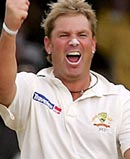

Australia Cricket Players

Shane Warne
Wisden Cricketer of the Year 1994
Selected as one of five Wisden cricketers of the century, 2000
Shane Keith Warne (born September 13, 1969 in Ferntree Gully, Victoria, Australia) is the captain of Hampshire. He is one of the greatest leg spin bowlers in history many say the greatest.
In 2000, he was selected by a panel of cricket experts as one of the five Wisden Cricketers of the Century. Since October 2004, he has held the record for the most wickets taken by any bowler in Test cricket, and in August 2005, he became the first bowler to take 600 Test wickets. He has, however, been plagued by scandals off the field throughout his playing career.
Warne made his first-class cricket debut in 1990-91, taking 0/61 and 1/41 for Victoria against Western Australia at the Junction Oval in Melbourne. With Australia searching for a leg spin bowler for its Test team, Warne was selected in the Australia B team which toured Zimbabwe in September 1991. His best performance was 7/52 in a four-day match. Back home, he took 3/14 and 4/42 for Australia A against the West Indies in December 1991, and was rushed into the team for the Third Test against India at the Sydney Cricket Ground a week later. He had an undistinguished debut, taking 1/150 (Ravi Shastri caught by Dean Jones for 206) off 45 overs, and recording figures of 1/228 in his first Test series. His poor return continued in the first innings against Sri Lanka at Colombo in the next year, in which he recorded 0/107. However, a spell of 3 for 11 in the second innings contributed to a remarkable Australian win and arguably saved his Test career. Despite the inauspicious start to his Test career, he has since revolutionised cricket thinking with his mastery of leg spin, which many cricket fans had regarded as a dying art. For all his wickets and off-pitch (and on pitch) controversies, Warne's place in cricketing posterity was assured by the fact that cricket had been dominated by fast bowling for about two decades before his debut. Despite the presence of high quality spin bowlers such as Abdul Qadir, Australia with Dennis Lillee and Jeff Thomson had dominated cricket in the early 1970s and, from 1976 until the early 1990s, the West Indies had lost only one (ill-tempered and controversial) test series with a bowling attack almost exclusively comprising fast bowlers. In the early 1990s, with the West Indies on the wane, Waqar Younis and Wasim Akram of Pakistan were assuming the mantle of the world's most feared bowlers. It was in that context that Warne's tormenting of batsmen became so significant, rather than his actual statistics. His humiliation of Gatting and subsequent hold on particularly English and South African batsmen provided a welcome sight for cricket watchers weary of the relentless intimidation of West Indian bowlers of the 1990s. Warne combined the ability to turn the ball prodigiously, even on unhelpful pitches, with unerring accuracy and a wide variation of deliveries (notably including the flipper).
Many of his most spectacular performances have occurred in Ashes series against England, whose players' inexperience against leg spin bowling made them particularly vulnerable. However, with feats like the famous "Gatting Ball" or "Ball of the Century" which spun sharply and bowled a bemused Mike Gatting in the 1993 Ashes series, most of the credit is Warne's. Conversely, he has struggled against India: his bowling average against them is a poor 47.18, compared with less than 31 against every other country. Warne has been highly effective bowling in one-day cricket, something few other leg spin bowlers have managed. He also captained Australia on several occasions in one-day internationals, winning ten matches and losing only one. Warne had intended to retire from ODI cricket at the end of the 2003 World Cup, as it transpired, his last game for Australia was in January 2003. However he did appear for the ICC World XI for the Tsunami benefit match in 2005. In March 2004, he became the second cricketer, after Courtney Walsh of the West Indies, to take 500 Test wickets. He broke the record for most career wickets in Test cricket on October 15, 2004 during the Second Test against India at Chennai, overtaking his great spin bowling rival, Muttiah Muralitharan of Sri Lanka. (As both Warne and Muralitharan are still playing, the record may change hands again, though Muralitharan has said he has no interest in regaining it). On 11 August 2005 at Old Trafford, in the Third Ashes Test, he became the first bowler in history to take 600 Test wickets. In 2005, he also broke the record for the number of wickets in a calendar year, with 96 wickets. Warne's ferocious competitiveness was a feature of the now legendary 2005 Ashes series. Warne took 40 wickets at an average of 19.92 in the series and scored 249 runs prompting some to comment that he could now make a justifiable claim to being the greatest bowler of all time. Together with Brett Lee, he was one Australian whose reputation was enhanced with every match, in contrast to his distinguished teammates who were constantly rattled by the strength of England's challenge. Warne is also noted for his exuberant (and sometimes effective) lower-order batting, once famously being dismissed for 99 with a reckless shot when a Test century beckoned, on what was later shown to be a no ball. In fact, Warne has scored the most Test runs without having scored a century, with another score in the 90s, in 2006 Warne and Glenn McGrath reportedly lost a bet of which bowler would be the first to get a Test century with fellow Australian bowler Jason Gillespie after Gillespie scored a record double century as a night-watchman against Bangladesh. Warne is also a useful slip fielder.
- Full name : Shane Keith Warne
- Born : September 13, 1969, Ferntree Gully, Victoria
- Batting style : Right-hand bat
- Bowling style : Legbreak googly
- Test debut : Australia v India at Sydney - Jan 2-6, 1992
- Last Test : Bangladesh v Australia at Chittagong (CDS) - Apr 16-20, 2006
- ODI debut : New Zealand v Australia at Wellington - Mar 24, 1993
- Last ODI : Asia XI v ICC World XI at Melbourne - Jan 10, 2005



